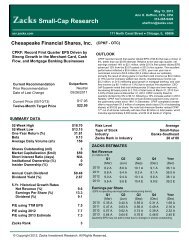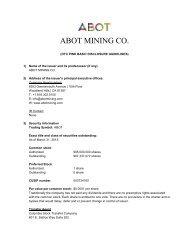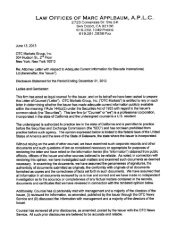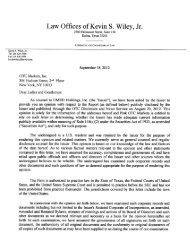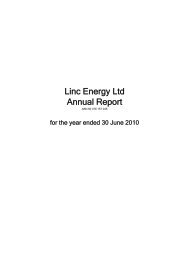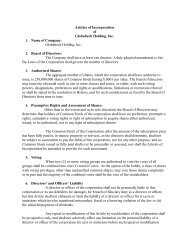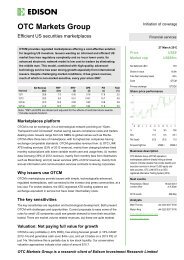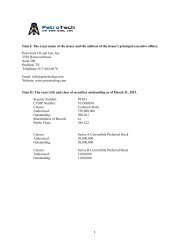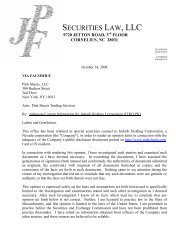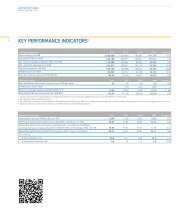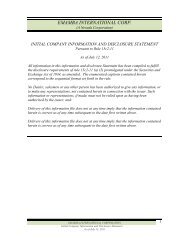2011 Annual Report - OTCIQ.com
2011 Annual Report - OTCIQ.com
2011 Annual Report - OTCIQ.com
You also want an ePaper? Increase the reach of your titles
YUMPU automatically turns print PDFs into web optimized ePapers that Google loves.
future exercise price. This amount is reclassified from a separate<br />
<strong>com</strong>ponent within non-controlling interests and reported<br />
separately as a liability. The reclassification occurs irrespective<br />
of the probability of exercise. The accretion of the liability<br />
is recognized as interest expense. If a purchase <strong>com</strong>mitment<br />
expires unexercised, the liability reverts to non-controlling<br />
interests. Any difference between liabilities and non-controlling<br />
interests is recognized directly in retained earnings.<br />
Where shareholders of entities own statutory, non-excludable<br />
rights of termination (as in the case of German partnerships,<br />
for example), such termination rights require the reclassification<br />
of non-controlling interests from equity into liabilities<br />
under IAS 32. The liability is recognized at the present value<br />
of the expected settlement amount irrespective of the probability<br />
of termination. Changes in the value of the liability are<br />
reported within other oper ating in<strong>com</strong>e. Accretion of the<br />
liability and the non-controlling shareholders’ share in net<br />
in<strong>com</strong>e are shown as interest expense.<br />
If an E.ON Group <strong>com</strong>pany buys treasury shares of E.ON AG,<br />
the value of the consideration paid, including directly attributable<br />
additional costs (net after in<strong>com</strong>e taxes), is deducted<br />
from E.ON AG’s equity until the shares are retired, distributed<br />
or resold. If such treasury shares are subsequently distributed<br />
or sold, the consideration received, net of any directly attributable<br />
additional transaction costs and associated in<strong>com</strong>e taxes,<br />
is added to E.ON AG’s equity.<br />
Share-Based Payment<br />
Share-based payment plans issued in the E.ON Group are<br />
accounted for in accordance with IFRS 2, “Share-Based Payment”<br />
(“IFRS 2”). The E.ON Share Performance Plan introduced in<br />
fiscal 2006 involves share-based payment transactions that are<br />
settled in cash and measured at fair value as of each balance<br />
sheet date. E.ON determines the fair value of the fifth tranche<br />
using the Monte Carlo simulation technique. From the sixth<br />
tranche forward, the 60-day average of the E. ON share price<br />
as of the balance sheet date is used as the fair value. In addition,<br />
the calculation of the provision for the sixth tranche takes<br />
into account the financial measures ROACE and WACC. The<br />
<strong>com</strong>pensation expense is recognized in the in<strong>com</strong>e statement<br />
pro rata over the vesting period.<br />
CEO Letter<br />
E.ON Stock<br />
Combined Group Management <strong>Report</strong><br />
Consolidated Financial Statements<br />
Corporate Governance <strong>Report</strong><br />
Supervisory Board and Board of Management<br />
Tables and Explanations<br />
Provisions for Pensions and Similar Obligations<br />
The valuation of defined benefit obligations in accordance<br />
with IAS 19, “Employee Benefits” (“IAS 19”), is based on actuarial<br />
<strong>com</strong>putations using the projected unit credit method,<br />
with actuarial valuations performed at year-end. The valuation<br />
en<strong>com</strong>passes both pension obligations and pension entitlements<br />
that are known on the balance sheet date, as well as<br />
economic trend assumptions made in order to reflect realistic<br />
expectations.<br />
Actuarial gains and losses that may arise from differences<br />
between the estimated and actual number of beneficiaries and<br />
from differences between the estimated and actual underlying<br />
assumptions are recognized in full in the period in which<br />
they occur. Such gains and losses are not reported within the<br />
Consolidated Statements of In<strong>com</strong>e but rather are recognized<br />
within the Statements of Recognized In<strong>com</strong>e and Expenses<br />
as part of equity.<br />
The employer service cost representing the additional benefits<br />
that employees earned under the benefit plan during the<br />
fiscal year is reported under personnel costs; interest cost<br />
and expected return on plan assets are reported under financial<br />
results.<br />
Unrecognized past service cost is recognized immediately to<br />
the extent that the benefits are already vested or else amortized<br />
on a straight-line basis over the average period until the<br />
benefits be<strong>com</strong>e vested.<br />
The amount reported on the balance sheet represents the<br />
present value of the defined benefit obligations adjusted for<br />
unrecognized past service cost and reduced by the fair value<br />
of plan assets. If a net asset position arises from this calculation,<br />
the amount is limited to the as yet unrecognized past<br />
service cost plus the present value of available refunds and of<br />
the reduction in future contributions and to the benefit from<br />
prepayments of minimum funding requirements.<br />
85



